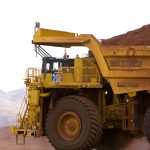 Recently I visited the Accenture Dock innovation facility in Dublin. One of the feature ‘exhibitions’ at the facility is the ‘mine of the future’. The mine uses an array of digital technologies based around five main pillars: Visualization and Alerts, Analytics and Dynamic Scheduling, Digital Twin, Integrated Automation and Cognitive Network.
Recently I visited the Accenture Dock innovation facility in Dublin. One of the feature ‘exhibitions’ at the facility is the ‘mine of the future’. The mine uses an array of digital technologies based around five main pillars: Visualization and Alerts, Analytics and Dynamic Scheduling, Digital Twin, Integrated Automation and Cognitive Network.
One of the companies that is perhaps furthest down this road is Rio Tinto, who are introducing autonomous trucks and drilling rigs to it’s iron-ore operations in Western Australia.
Here, 74 enormous trucks (out of a total fleet of around 400) operate apparently autonomously, operated by staff located two hours flight away in Perth. The company believe that the machines are capable of operating at around the same level as their human driven counterparts, but of course they can go almost non-stop. This absence of any rest breaks, driver changeovers and so on adds up over a full day, and saves the company around 15%. Executives at the company say that the rigs are running for around a third more time than manned rigs, and are capable of churning through 10% more meters per hour.
Leading the way
It’s probably fair to say that Rio are at the forefront of such digitization of the mining industry, and plan to roll-out driverless trains along the 1,700km of track between 16 of it’s mines and four ports. It has already conducted a 100km test run, where 6% improvements in average speed were recorded. Couple that with the removal of driver-changes and each small improvement adds up to something significant.
It’s part of a digital transformation that Accenture believe can unlock $38 billion for the industry in the next few years. They believe that for the industry to achieve this however, they need to move beyond individual, standalone projects and take a more holistic approach. They advocate a number of key steps for executives to take:
- Unify the vision – Ensure that all digital initiatives are governed and managed by a single ‘board’ to ensure that each works together towards a common strategy.
- Develop a broad ecosystem – Potential ideas and technologies can come from a wide range of sources, and especially from outside the mining industry. It’s important therefore to have a broad ecosystem of partners.
- Be agile – Agile methodologies are a common part of innovation processes today and allow organizations to adopt an experimental approach to change. Accenture believe that because they involve the end user from the start, they also have a higher success rate.
- Place AI at the heart – Whilst some companies are building up in-house AI capabilities, they are probably outliers at the moment. The potential for the technology is significant however, and so competition for talent is likely to intensify.
The industry is not only increasingly competitive, but the cost pressures are common across the board. Digital transformation is likely to be on the agenda for miners of all sorts therefore. Rio are arguably leading the way, but there is significant potential for all companies to improve their operations, with the World Economic Forum predicting earlier this year that $190 billion in value could be unlocked in the industry by digital technologies over the next decade.
So whilst there are arguably sexier industries out there, the mining sector is certainly one of the more interesting to observe the impact digital technology is, and will have.